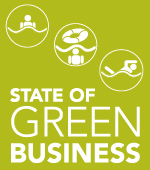Companies Learn to Close the Loop
<p>From Starbucks to Walmart, companies have been taking major strides in giving what would normally be waste at least one more go-round on store shelves.</p>

[Editor's Note: This is part of a series of articles excerpted from our annual State of Green Business Report. The report takes a close look at the data behind the green business movement to track whether we're moving the needle on corporate sustainability. Download the free report here.]
The promise of a closed-loop society -- where everything is recycled endlessly into new products and packaging -- remains a distant dream, though it creeps ever closer. Companies are finding new and innovative ways to turn old things into new things. It's far from the Holy Grail of Cradle to Cradle -- in which every material is recycled back to a raw material or into a benign or beneficial soil amendment -- but it's a start.
Sometimes, a little recycling becomes a stepping-stone to a bigger achievement. For example, Starbucks announced it had completed a test toward a longstanding goal: turning used coffee cups into new cups. The coffee giant said it wants to provide only recyclable or reusable cups by 2015, and has run various recycling projects to see what its cups can be turned into. Its pilot project sent about 8,000 pounds of cups to a company that provides the post-consumer content that's been in Starbucks' cups since 2006. The pulp processor sends the pulp to various companies that make Starbucks' cups. All of the companies' cups, including the newest ones, have 10 percent recycled content.
Starbucks has put plenty of time and effort into promoting recycling of its cups. It hosted two "cup summits" to bring together all of the relevant paper and recycling players. It also sponsored a contest seeking ways to reduce the number of non-recyclable cups leaving its stores, which resulted in several submissions for how to encourage customers to opt for reusable cups. For all this, Starbucks still has a ways to go: Only a small fraction of the four billion cups it produces a year are kept out of landfills.
Walmart threw its hat into the loop, too, in the form of a pilot project with TerraCycle, the maverick manufacturer of consumer products made from branded waste packaging. TerraCycle converts waste like candy wrappers, yogurt tubs, pens, and coffee bags into products such as tote bags, plant pots, backpacks, pencil cases and portable speakers. Five U.S. Walmart stores began testing a collection system for 28 types of trash to send to TerraCycle. Walmart also launched a partnership with a firm called Worldwise, in which the retailer will sell pet products made from recycled materials -- dog beds made from used plastic soda bottles, cat scratchers made from recycled hangers, litter liners made from old paper bags, and the like.
There are others. Hasbro, maker of G.I. Joe, Transformers, and other iconic toys and games, said it would increase the recycled content of its packaging and paper materials to 75 percent in 2011. Massachusetts-based Recycline said it collected 50 tons of used polypropylene plastic in 2010 though its Gimme 5 recycling program (polypropylene is marked as No. 5 in the plastics coding system), turning it into toothbrushes and other goods. The company makes razors, plates, mixing bowls, and more out of 100 percent recycled polypropylene, which is rarely accepted in recycling programs. Pepsi-owned Naked Juice said it is making good on its plan to convert all of its bottles to recycled content. Last year, it began transitioning its juices and smoothie bottles to 100 percent post-consumer recycled content.
True, some of these efforts may seem underwhelming, given the 300 million or so tons of trash that comprise the municipal solid waste stream in the U.S. each year. But each must break through barriers to succeed, not the least of which is the lack of an infrastructure to recycle many types of packaging and product waste.
In truth, many of these efforts aren't really closed-loop. They involve increasing recycled content in products or "upcycling" waste into new products or packaging. Such cycles are finite -- perhaps amounting to just one additional use for a given item -- and eventually, most will end up in landfills. That they get a second life is laudable -- though it only delays the inevitable.






